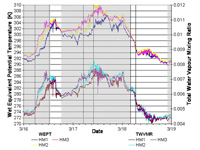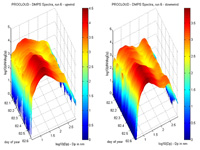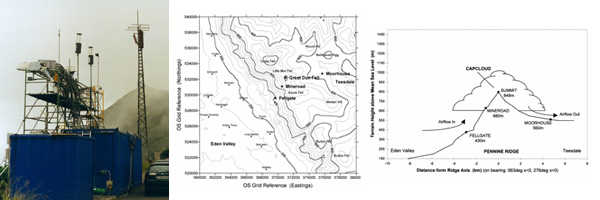Multiple Site Ground Based Cloud Experiments
Traditionally ground based cloud studies have been done with multiple site experiments involving at least three sites, one upwind, one downwind and one at the summit of the hill. At the upwind and downwind sites detailed measurements are made of aerosol and gas phase properties. In particular aerosol size distribution, hygroscopic properties and chemical composition, and concentrations of gases such as SO2, NOx, H2O2, NH4, CO and O3 are measured. At the hill top site measurements are made of cloud properties such as droplet size distribution, total liquid water content and cloud droplet chemical composition as a function of droplet size. Additionally measurements are made using an interstitial inlet (which allows only particles below a certain size – typically 2.5µm – to enter) of the properties of aerosol and gases which have not entered the cloud phase.
Temperature and relative humidity measurements are made at all three sites to allow for a thermodynamic analysis of flow connection between the sites. Thus it is possible to determine when the same air mass is passing over all the sites, or when the sites are sampling different air masses. This is important because comparisons of measurements made at all three sites form a major aspect of these experiments. With temperature and humidity data from weather balloons it is possible to determine how much air has been mixed (entrained) into the cloud from above.

Hill cap cloud experiments can provide almost laboratory conditions under which cloud properties can be studied. Orographic hill cap clouds are in general relatively isolated simple clouds. Their lifetime is such that precipitation forming mechanisms can be ignored, they are relatively simple to model and the inputs to and outputs from the cloud can be well characterised. In-situe measurements made at ground based sites can also be much more detailed than is possible using airborne platforms. The processes studied in hill cap clouds can readily be applied to other cloud types. These experiments have been used extensively to study cloud-aerosol interactions in different air masses ranging from clean marine and continental air masses to those which have been heavily influenced by urban pollution. Studies have looked at how aerosol size distribution, hygroscopic properties and chemical composition influence the characteristics of the cloud, particularly cloud droplet size distribution.
Cloud droplet size distribution is an important parameter in determining the radiative effects of clouds. For a given water content, a cloud with relatively smaller drops is a better reflector of incoming solar radiation than one with fewer larger drops. Additionally droplet size effects the lifetime of the cloud by influencing its ability to produce precipitation. A cloud which has smaller droplets takes longer to produce precipitation, and hence has a longer lifetime in the atmosphere. Results from hill cloud experiments have shown that cloud droplet number is very sensitive to changes in aerosol size distribution and chemical composition. In general when aerosol are highly soluble droplet number increases with aerosol number. If the aerosol are less soluble, increases in droplet number are smaller. The effect of enhanced aerosol concentrations on cloud is referred to (in radiative forcing terms) as the indirect aerosol effect, and is sometimes divided into the Twomey (enhanced reflectivity) and Albrecht (increased lifetime) effects.

An example of a typical multi site orographic hill cap cloud project was the Holme Moss PROCLOUD project. This project was carried out over the Pennines to the East of Manchester and was designed to study cloud processing of a polluted urban plume. More details about this project can be found here.
